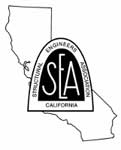Invited Speaker Abstract
Hurricanes, Tornados, Floods and other Disasters: A View from Space
Ronald T. Eguchi
ImageCat, Inc.
imagecatinc.com
rte [at] imagecatinc.com
In many instances, disasters act as catalysts in the adoption of new and emerging technologies. Spawned by the need to rapidly collect vital information for disaster management, technology innovations have often helped emergency responders to assess the impact of large disasters more efficiently and rapidly, and to track and monitor progress in critical response and recovery operations. Some examples of where technology implementation has been driven by the occurrence of a major disaster include Hurricane Andrew in 1992, where the lack of rapid damage or situation assessment tools hindered the deployment of federal resources and thus identified the need for near real-time loss estimation methodologies; Hurricane Charley in 2004 where the deployment of GPS-based, field survey technologies helped to freeze in time the damage and destruction of this disaster so that researchers could study the effects of significant wind hazards in a more comprehensive and complete manner; and Super Storm Sandy in 2012 where the notion of mobilizing “the crowd” as a scalable workforce to provide rapid, near real-time damage assessments using very high resolution aerial imagery helped federal agencies respond much faster and more effectively than in previous disasters. All of these events underscore the opportunities that emerge when time-critical information can be delivered more efficiently to users making critical decisions during the disaster.
One technology which has had an enormous impact on disaster management has been remote sensing. In the past decade, this technology has been used extensively to explain the extent of impacts caused by earthquakes, tsunamis, hurricanes, floods, wildfires and terrorist attacks. Through high-resolution optical imagery and active sensors (e.g., synthetic aperture radar, or more commonly known as SAR, and light detection and ranging or LIDAR), remote sensing technologies have demonstrated significant efficacies in quantifying post-disaster damage, monitoring recovery and reconstruction progress after significant disasters, and more recently, in developing information on our urban infrastructure. One main reason for this rapid progress has been the introduction of high-resolution, commercially-available satellite imagery. Where these technologies used to be available to mainly government agencies (mostly military), they have now become readily accessible to the public. The impact of this development has been most noticeable in the disaster management area.
This presentation will focus on the integration of remote sensing technologies in all aspects of disaster management, i.e., disaster preparedness, mitigation, response and recovery. In order to demonstrate their efficacy in these four areas, cases histories and examples from recent disasters, including Hurricanes Charley (2004) and Katrina (2005), the Minot Floods in North Dakota (2011), the Joplin Tornado in Missouri (2011) and Super Storm Sandy (2012) will be presented. Finally, the presentation will end with a view towards the future. What new developments can be expected in technology development and implementation, what future challenges must be overcome to realize broader application of these technologies in future disasters, and what role will our younger researchers play in institutionalizing these technologies as essential tools in disaster management.
Bio
Mr. Eguchi is President and CEO of ImageCat, Inc., a risk management company specializing in the development and use of advanced technologies for risk assessment and reduction. He has directed major research and application studies in these areas for government agencies and private industry. He currently serves or has served on several Editorial Boards including the Natural Hazards Review published by the American Society of Civil Engineers and the Natural Hazards Research and Applications Information Center, University of Colorado; the Journal on Uncertainties in Engineering Mechanics published by Resonance Publications, Inc.; and the Earthquake Engineering Research Institute’s Journal SPECTRA. He is a member of the U.S. National Research Council’s Disaster Roundtable whose mission it is to identify urgent and important issues related to the understanding and mitigation of natural, technological, and other disasters. He is a past member of the Scientific Advisory Committee of the U.S. Geological Survey, a committee that reports to the U.S. Congress on recommended research directions for the USGS in the area of earthquake hazard reduction. In 1997, he was awarded the ASCE C. Martin Duke Award for his contributions to the area of lifeline earthquake engineering. He still remains active in the ASCE Technical Council on Lifeline Earthquake Engineering serving on several committees and having chaired the Council’s Executive Committee in 1991. In 2006, he accepted an ATC Award of Excellence on behalf of the ATC-61 project team for work on An Independent Study to Assess Future Savings from Mitigation Activities that showed that a dollar spent on hazard mitigation saves the nation about $4 in future benefits. He was recently recognized by EERI as the 2008 Distinguished Lecture where he discussed the topic of “Earthquakes, Hurricanes, and other Disasters: A View from Space.” He was also invited as a keynote speaker to the 14th World Conference on Earthquake Engineering, held in Beijing, China in 2008. He has authored over 300 publications, many of them dealing with the seismic risk of utility lifeline systems and the use of remote sensing technologies for disaster response.
Conference Hosts: 
![]()

12ACWE Sponsors


![]()
![]()
![]()
![]()
